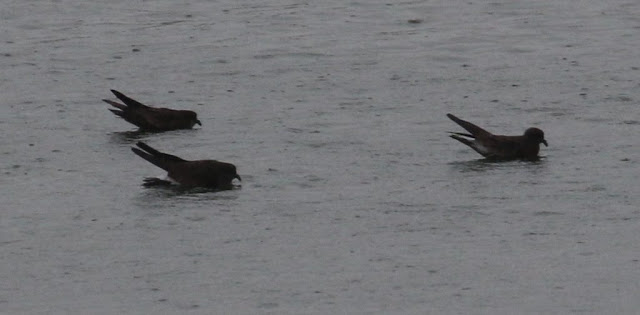Hurricane Birding Season Is Here! What Will It Bring?
By Brian Nicholas

Least Storm-Petrel at Patagonia Lake—not a bird often photographed with cattails in the background. Photo by Chris McCreedy/Macaulay Library.
On September 7, 2016, the world of Arizona birding changed significantly. It was the day the remnants of Hurricane Newton passed through our state, bringing with it three new state records, one a potential new ABA area record (Juan Fernandez Petrel). Amado Sewage Ponds recorded three unexpected tubenoses (birds that spend most of their time out in the oceans): Least Storm-Petrel, Wedge-rumped Storm-Petrel, and a flyover Wedge-tailed Shearwater.
Hurricane Newton was special but not unusual. On average a hurricane will cross into Arizona as a tropical storm or depression every five years. Other hurricane systems may arrive as remnants, which can also bring unexpected seabirds inland.
 |
| Wedge-tailed Shearwater, a tremor-inducing bird, over Amado WTP in Arizona. Photo by Laurens Halsey/Macaulay Library. |
 |
| Thanks to Andrew Core for this excellent map depicting Newton’s track and rarities. See the interactive map here. |
 |
| Three Wedge-rumped Storm-Petrels hanging out at the Amado pond. Photo by Laurens Halsey/Macaulay Library. |
It’s almost certain that other rare birds were missed during Newton. Here are some suggestions to improve our documentation of the next fallout event.
- Knowledge of the storm path. As with Newton, the stronger winds and bird fallout will tend to be just east of the eye of the storm system. Mountain ranges can block this flow and produce bird fallout, as the Rincon Mountains did with Newton.
- Extensive birder coverage of potential fallout areas. Many locations in Pima County were missed when birders went to Amado ponds for the rarities. Arivaca Lake, the largest body of water in Pima County, went uncovered that day.
- Adequate coverage of lighted parks or ball fields at dusk. Some of the Hurricane Newton seabirds were attracted to these lighted areas in the evening.
- Up-to-the-minute communication methods. Bird chats are probably the fastest medium but Facebook groups could also be effective.
- Effective documentation tools and techniques. Capturing an ID of a storm petrel or other seabird may require many viewing angles and possibly even video of behavior.
- Preparedness for the torrential rain associated with these storms are a must. Wearable umbrellas can protect your camera and yourself during these storms.
- Familiarization of seabird identifications. Helpful, though physical documentation will most likely be needed. A laminated foldout chart of seabirds in flight would be optimal, like the ones available for snakes and butterflies.
I’ve created a map for Pima County that shows top priority and secondary search areas. It also includes likely, unlikely, and downright implausible “hurricane species” (like Newton’s Juan Fernandez Petrel) which could make it here during a hurricane event. Clicking on each species will provide an eBird link to descriptions and photos. The species list includes seabirds, shorebirds, swallows, swifts, gulls, terns, tropicbirds and even grassquits!
 |
| Juan Fernandez Petrel! World’s most unexpected yardbird? Photo by Brian Gibbons/Macaulay Library. |
I am excited and anxious about the next hurricane event that reaches Arizona and the birds it may bring. Hurricane Lorena in 2019 was so weak that it didn’t even reach Arizona as a remnant, yet that day I spotted a magnificent Wood Stork at Canoa Ranch Conservation Area, flying south after the storm system had passed. May the birds be with you this hurricane season!
NOTE: Heavy rains associated with even remnants of hurricanes can be very dangerous. Please use caution and common sense when deciding whether or not to bird during these events.
Thanks to Chris McCreedy for contributing to this article.
More info on hurricane birds in Arizona:
- Tropical Storm Nora, 1997
- Least Storm-Petrel in Tucson, 2016
- Juan Fernandez Petrel in Tucson, 2016
- eBird report on the birds of Newton (a must read!)
- Hurricane Newton Wiki
- Eastern Pacific Five Day Tropical Weather Outlook

Comments
Post a Comment
Thanks, we value your opinions! Your comment will be reviewed before being published.